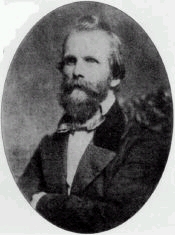Hammatt Billings 1818-1874
Marriage Search Engines - YourFamilyFacts.com - SSDI-Search.com - Surname Search Utility
Hammatt Billings 1818-1874
Marriage Search Engines - YourFamilyFacts.com - SSDI-Search.com - Surname Search Utility
| Architect & Designer
In the Old Burying Grounds of the Milton Cemetery, there is a large granite monument with a bronze laurel leaf wreath that commemorates the grave of native-born 19th century architect Hammatt Billings. Charles Howland Hammatt Billings (1818-1874) was the son of Ebenezer and Mary Davenport Billings who kept the Blue Hill Tavern on Canton Avenue in Milton in the early 19th century. The tavern had been built in 1681 by Roger Billings, but by the early 1820's it had become an "elegant tavern, boarding-house, and fruit gardens, kept by Ebenezer Billings, which is one of the most delightful summer retreats in this neighborhood." Hammatt Billings, as he was to be known in his professional life, was apprenticed about 1830 to the noted wood engraver Abel Bowen with whom he remained until 1837 when he joined the architectural office of Ammi Burnham Young who was then in the process of designing the Boston Custom House. With his training as an engraver, Mr. Billings was to become a capable designer and trained architect, so when he opened his own architectural office at 460 Washington Street in Boston (now the site of the Registry at the Liberty Tree Building at Washington and Essex Streets) in 1843 he was well-rounded in the various aspects of architectural design. Self-proclaimed as a "Designer and Architect," Mr. Billings often worked with his brother Joseph Billings, who was an engineer. This partnership, a lose one at best, would lead Hammatt Billings to design houses, churches, clubhouses, commercial blocks and libraries throughout New England. His style of architecture, which might best be described as the "classically picturesque," would gain him the commission to design the Boston Museum on Tremont Street in Boston. Designed as an exhibition hall and theatre with monumental Corinthian columns supporting the galleries, the Boston Museum was an early example of the Renaissance Revival in Boston, with a dressed granite facade and arched windows. Mr. Billings later went on to design the campus of Wellesley College between 1869 and his death in 1874. Using a picturesque approach to the overall campus design, he had serpentine roads leading to impressive buildings that ranged around a lake. A talented and gifted architect, it was said of him that "he expressed rather than led his generation" in architectural design. However, his "Monument to the Pilgrim Forefathers," begun in 1859, was probably his best known design. An 83-foot granite base supported a 70-foot colossal figure of "Faith," which held a book in one hand and pointed towards the Heavens with the other. This monument, of which there is a bronze model on the mantel in the Reading Room of the Milton Public Library, was thought to be the forerunner of Bartholdi's Statue of Liberty, but "Faith" was not finished until 25 years after Mr. Billings' death, after having been reduced in size and reworked and altered by other artists. However, his grave in Milton proudly proclaims that he was the "Architect to the Monument to Our Pilgrim Forefathers." Surprisingly, as an architect Mr. Billings had shown great talent, but he never really achieved fame. However, in the designing and illustration of books, which he learned through his apprenticeship with Abel Bowen, he became mildly famous. In 1847, Henry Wadsworth Longfellow called him "the best illustrator of books we have yet had in this country." This was noteworthy praise, as Mr. Billings had illustrated Mother Goose for Grown Folks, which was written by Milton authoress Adeline D. Train Whitney. His illustrations were thought so good that he was commissioned to create "the original likenesses of Torn, Little Eva, Topsy, Legree, and other characters in Harriet Beecher Stowe's Uncle Tom's Cabin." His career as an illustrator, like that of his career as an architect, was "breathtakingly varied." He was associated with Gleason's as well as Ballous Pictorial Drawing Room Companion, Boston newsweeklies, of which he was one of numerous illustrators, including Winslow Homer, who made pictorial illustrations. Though not one who forged ahead in architectural design and went on to become well known, Hammatt Billings is one who contributed to the rich fabric of Boston life in the mid nineteenth century and who gave "visible form to the personal, civil, patriotic, and other public sentiments pervasive at the time in Boston and beyond" and is once again remembered by his fellow townsmen, with pride. |

Hammatt Billings 
|